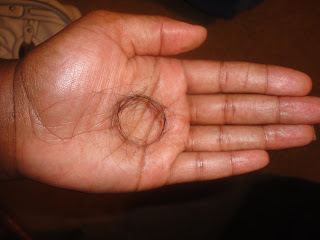I couldn't wait to start this series. The first topic of my Revisiting Childhood Series is HAIR GREASE! You probably could’ve guessed that this would be the first topic. I don’t know one single African American or black girl who did not use hair grease as a child. (There are probably some but I don’t know any, lol.) Grease was a staple in maintaining curly kinky afro-textured hair. You would grease your scalp, grease the length of your hair, use grease with a pressing comb to ensure you got straight shiny hair. I even remember using grease if I was out of lotion or if I needed lip balm….crazy I know, but grease had multiple uses back in the day. Grease, unfortunately, is not something I will use now on my hair or my daughter’s hair.

The Good
You are probably thinking just like I was, if hair grease is so bad, then why when I was a child I used it and had long healthy hair? Grease or any petroleum based product will provide lubrication to the hair shaft which is much needed in afro-textured hair in order to make it manageable and pliable for styling, thus minimizing breakage. This coupled with the protective and low-manipulation styles most of us wore as children, such as braids or twists, will result in hair that retains length and eventually grows to longer lengths. Also, because petroleum contains water repelling carbons it is a great sealant for the hair shaft, locking in moisture by acting as a impenetrable barrier through which the moisture cannot escape (see the bad where I also talk about how moisture cannot enter as well).

The Bad
The truth is, grease is horrible for your hair and scalp. Even though many of you may already know that now, let me explain. Normally in hair grease, the number one ingredient is petroleum. The petroleum in the grease acts a barrier that does not let your scalp breath. It can clog your hair follicles. Clogged hair follicles may produce hair, but it will not give you optimal hair growth and healthiness. In fact, clogged pores can lead to dandruff and sluggish hair growth. It’s funny that it is believed that using grease is a remedy for dry, flaky scalp but actually that will exacerbate the problem because grease is not moisture, and a dry scalp needs moisture. Grease actually blocks moisture from getting to your scalp as well as the rest of your hair shaft. Once the grease is coating your hair shaft, it will be difficult for moisture in enter your strands. Your hair will be shiny, but do not mistake shiny hair for moisturized hair. Afro-textured hair needs regular moisturizing, if not daily, to be healthy. Using too much grease can create a layer of petroleum on the hair shaft that water based moisturizers cannot get through to moisturize the hair.
Another thing your must take into consideration when using hair grease regularly is that regular shampoo may not be sufficient to cleanse your hair. Because of its consistency, a clarifying shampoo should be used to ensure all of the product is properly removed from your hair.

The Verdict
If you have found a way to incorporate grease into your hair routine that has yielded successful results, by all means continue to use what works best for you. I am a firm believer that what works for one person may not work for another. I wanted this post to be informative touching on both the good and bad as it pertains to hair grease. My personal verdict is not to use it because there are other products that will do what grease does and better, without any negative side effects. For example, coconut oil would be a good substitute.
Coconut oil can:
- Provide lubrication to the hair shaft making it manageable for styling.
- Combat flaky dry scalp without clogging follicles or retarding hair growth.
- Seal in moisture while still allowing moisture to be able to enter the hair.
Additional benefits of coconut oil not found in hair grease:
- Coconut oil has the ability to penetrate the hair shaft thus providing deep conditioning.
- Coconut oil reduces protein loss in the hair, which in turn minimizes breakage of the strands.
































